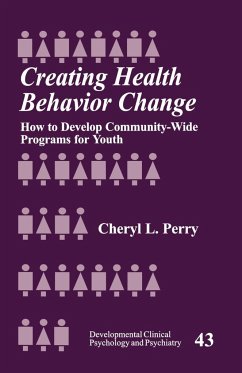
Creating Infrastructures for Latino Mental Health

PAYBACK Punkte
38 °P sammeln!
Latinos are the fastest growing and largest minority group in the United States. In 2008, this group numbered over 47 million; by 2050, the population is expected to triple, reaching 133 million. Traditionally, Latinos have immigrated to large urban centers (e.g., New York, Los Angeles) that over long periods of time developed a complex infrastructure to receive new immigrants. Increasingly, new Spanish-speaking immigrants are moving into areas of the country previously unfamiliar to them. Although urban co-ethnic communities continue to be the destination of many newcomers, immigrants from Mexico, Central America, and South America in pursuit of low-skilled labor opportunities are settling in small towns and rural areas of the South and Midwest. This new demographic trend has resulted in the creation of the term "new growth communities," which refers to small rural areas that are now home to a small but rapidly growing Hispanic population. Unfortunately, these communities, which are now present in many states across the country (e.g., Illinois, North Carolina), lack the infrastructure necessary to meet the needs of Latino immigrants (e.g., access to health care, immigration assistance, and breaking down language barriers). The lack of an infrastructure and the lack of an established ethnic community to facilitate the assimilation of new immigrants present an ongoing challenge, especially in the area of Latino mental health. The volume focuses on dealing with systemic issues and on providing innovative ideas for development of infrastructure of services. This text will advance ways to understand and ameliorate mental health disparities both from research and experiential perspectives.
The growing Latino population of the United States stands poised to shape the nation s future throughout the twenty-first century, yet serious obstacles hinder the full participation of the Latino community in American society. Access to mental health care poses a particular challenge for many segments of the population. Although significant scholarship has focused on the delivery of culturally competent practice, few academic resources address systemic issues that affect the actual delivery of services to Latino clients. In response, Creating Infrastructures for Latino Mental Health provides the first interdisciplinary guide aimed at improving access to mental health services. Experts from several specialties provide state-of-the-art analyses and innovative strategies for tackling the structural, organizational, and linguistic issues that contribute to service inequities. Collectively, the book chapters call attention to clinical, geographical, and social contexts, as well as topopulations as varied as breast cancer survivors, rural new growth communities, and unaccompanied immigrant youth. The authors provide an exquisite array of intersecting topics linked by a common theme: the need for a broad social response to transform mental health service for Latinos. Among the topics covered:
· Infrastructure development aimed at specific dimensions of structural inequality
· The role of government in facilitating the development of infrastructures
· The need for federal policy to protect immigrants and aid in their incorporation
· Building local infrastructures attuned to the specific needs of communities
· Developing a bilingual workforce through interdisciplinary collaboration, organizational planning, and training of staff and interpreters
· Addressing the mental health needs of Latino youth in the juvenile justice system
· Expanding educational opportunities for first-generation college students
· Supporting Latino families caring for persons with serious mental illness
"An extraordinary contribution to multiple stakeholders. Provides guideposts for policy-makers, administrators, researchers and clinicians alike. -- Patricia Arredondo, EdD, Associate Vice Chancellor for Academic Affairs, University of WI-Milwaukee
This book's comprehensive compendium of knowledge of Latino mental health makes it indispensable reading not only for mental health professionals, social workers and educators but for all those interested in the psychology and culture of the fastest growing population in America. -- Pastora San Juan Cafferty, PhD, Professor Emerita, School of Social Service Administration, University of Chicago
This book addresses tremendous gaps in the fields of Latino mental health and healthcare. Packed with useful information, innovative perspectives, and actionable policy recommendations, this interdisciplinary effort undoubtedly will become a go-to resource in meeting the mental-health needs of Latinos. -- Glenn Flores, MD, FAAP, Director, Division of General Pediatrics, Professor of Pediatrics, Clinical Sciences, and Public Health, The Judith and Charles Ginsburg Chair in Pediatrics, UT Southwestern Medical Center and Children's Medical Center Dallas
· Infrastructure development aimed at specific dimensions of structural inequality
· The role of government in facilitating the development of infrastructures
· The need for federal policy to protect immigrants and aid in their incorporation
· Building local infrastructures attuned to the specific needs of communities
· Developing a bilingual workforce through interdisciplinary collaboration, organizational planning, and training of staff and interpreters
· Addressing the mental health needs of Latino youth in the juvenile justice system
· Expanding educational opportunities for first-generation college students
· Supporting Latino families caring for persons with serious mental illness
"An extraordinary contribution to multiple stakeholders. Provides guideposts for policy-makers, administrators, researchers and clinicians alike. -- Patricia Arredondo, EdD, Associate Vice Chancellor for Academic Affairs, University of WI-Milwaukee
This book's comprehensive compendium of knowledge of Latino mental health makes it indispensable reading not only for mental health professionals, social workers and educators but for all those interested in the psychology and culture of the fastest growing population in America. -- Pastora San Juan Cafferty, PhD, Professor Emerita, School of Social Service Administration, University of Chicago
This book addresses tremendous gaps in the fields of Latino mental health and healthcare. Packed with useful information, innovative perspectives, and actionable policy recommendations, this interdisciplinary effort undoubtedly will become a go-to resource in meeting the mental-health needs of Latinos. -- Glenn Flores, MD, FAAP, Director, Division of General Pediatrics, Professor of Pediatrics, Clinical Sciences, and Public Health, The Judith and Charles Ginsburg Chair in Pediatrics, UT Southwestern Medical Center and Children's Medical Center Dallas














